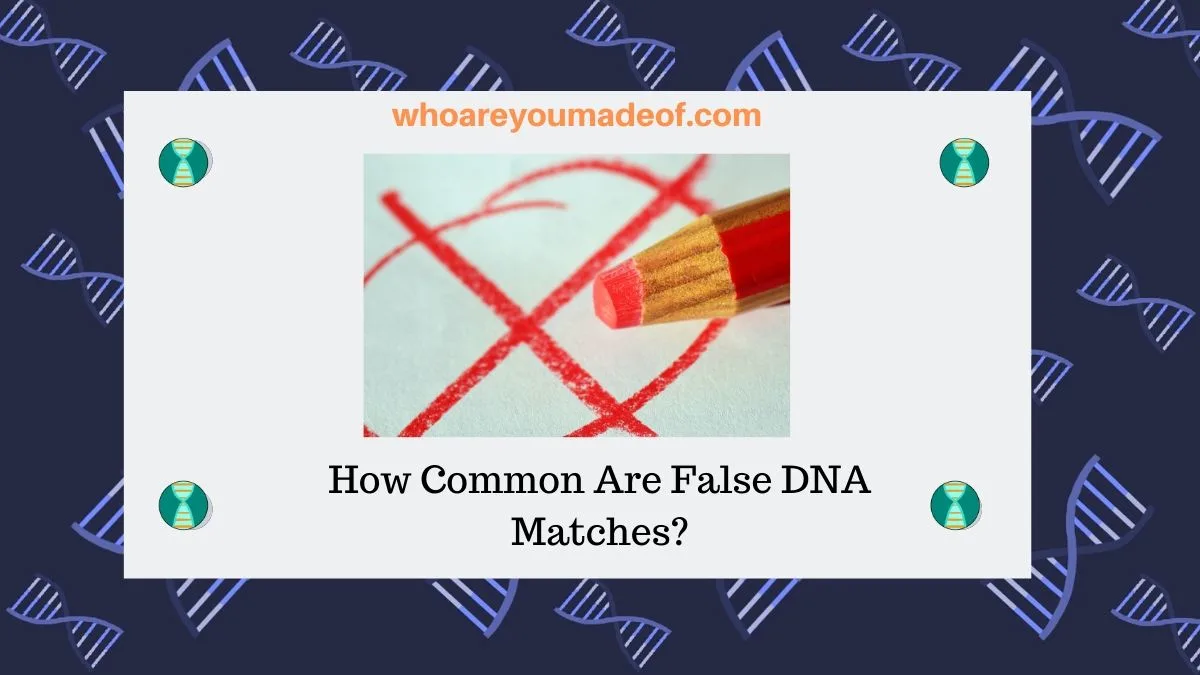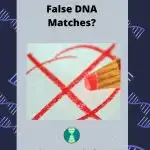Do you have DNA matches that appear to be false? Do you want to know how common false DNA matches are? In this post, you will learn how frequently this occurs and how to spot false DNA matches.
It's important to know how likely it is that a particular DNA match is false. I'm sure I'm not the only one who has spent hours trying to track down my connection to a match only to realize that we are probably not related in any meaningful way.

Understanding false DNA matches can help save you lots of time and frustration. You can instead focus your energy on researching matches that are most likely legitimately related to you.
The key to understanding false DNA matches is knowing that our DNA matches share at least one identical DNA segment with us. We can share multiple DNA segments with the same match. Typically, we will share lots of DNA segments with our closer relatives, and less DNA segments with more distant relatives.
(The exception to this statement are DNA matches from endogamous populations)
False DNA matches: How common are they really?
Now we understand that when we refer to DNA matches, we really mean that we share matching DNA segments with those individuals on our DNA match list. Is there an easy way to know whether a DNA segment is really identical, or whether it is likely to be a false match?
There is no hard and fast, 100% guaranteed rule, but there are some guidelines we can use to help us.
Below are a few easy things to remember about half-identical segments, which are the type of segments that we usually refer to when we talk about DNA matches who share identical DNA segments:
- Segments that are larger than 15 cMs in length are almost never false
- Less than half of segments between 10-15 cMs in length are false
- More than half of segments less than 10 cMs in length are false
- Most DNA segments less than 5 cM in length are false
It should be mentioned that DNA matches that share segments that are less than 10 cMs in length with us might be related to us so distantly that it could be impossible to know for sure whether we share a common ancestor. Rare is the person who is able to build their family tree back 10+ generations on each and every line.
How do we get false DNA matches?
How do experts know that more than half of matching DNA segments smaller than 10 cMs are false? How do we get false DNA matches?
- Mistake in matching algorithm
- DNA testing companies don't examine paternal and maternal chromosome individually (pseudosegments)
This information is relatively easily obtainable if you have access to DNA information from both parents. If your parents or siblings haven't yet tested, it might be a good idea to have them test so you can avoid false matches.
For example, if you have lots of DNA matches with whom you share small segments (i.e. smaller than 10 cMs) and you compare your parents' DNA match lists to see if those same people show up, you will find that many of them won't be there.
We call identical DNA segments shared between two people that DO show up once the segments have been compared with the parents' DNA as "identical-by-descent" (IBD) segments. Segments that a person has that their parents don't have are called "identical-by-state" (IBS) segments.
The technical term for eliminating DNA segments that are not identical-by-descent from our DNA data is called "phasing". On the Gedmatch site, you can upload you and your parents' DNA and create phased DNA kits.
You can read more about creating phased DNA kits, which can only be used on Gedmatch, here:
How to know if a DNA match is false
If you think you might have found a false DNA match, there are a few things that you can do to test your theory. I recommend first assuming that the match is related and doing everything that you can in order to find out how you are connected to your match.
First, check to see if your DNA match also shows up as a match with your parents or other close relatives who have also done DNA tests. If you share close relatives in common as matches, it increases the likelihood that you share a branch in your family tree.
The next thing that you can do is closely examine the family tree information of your DNA match in order to see if you can see common surnames. You might also check to see whether you have ancestors from the same geographic region.
Even having ancestors from the same country might provide a clue.
Occasionally, if I find a way in which I might be connected to match, I find that doing a little research to extend their family tree (or mine) back a generation or two, if possible, can lead to identifying our relationship. I sometimes call this building a "quick and dirty tree" for my matches.
Even if I do eventually find a connection many generations back, I can't be sure that our DNA relationship is based on that genealogical relationship. It's possible to be related to someone distantly in several ways, yet share legitimate matching DNA segments from an unknown family connection.
Alternatively, it's possible to be truly related to a distant DNA match and share false DNA segment.
Conclusion
I hope that this post has helped you understand more about the probability of finding false DNA matches on your match list, and how to spot false matches. If you have any questions about something you read in this post or if you would like to share your own experience finding false matches, please join us in the discussion below.
Thanks for stopping by today.



Jamie
Sunday 22nd of September 2024
Hi,
I have a match with a lady on MyHeritage at 52.2 cM, with three segments, the longest being 33.3 cM. She doesn't match with my mother or father.
Isn't this rather high for a false match?